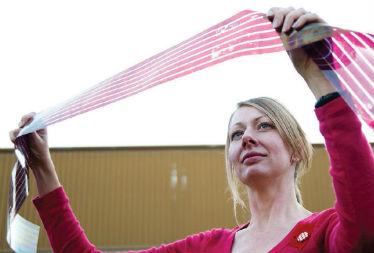We have come a long way from marveling at the solar-powered calculator, to wondering when the heck innovators are going to give us solar-powered smartphones, which house most of our calculators these days too. While the average energy consumer is busy worrying about such everyday concerns (author included), scientists at the Victorian Organic Solar Cell Consortium (VICOSC) are wondering how to power entire buildings, and after that—pretty much the whole planet–as the technology they are creating will be easily transferred to developing and third-world areas, inexpensively, thanks (once again) to the new hero in so many sciences and industries: 3D printing and design.
Since 2007, a large group of Australian scientists, working together as the Victorian Organic Solar Cell Consortium, and composed of talent from Monash University, the University of Melbourne, CSIRO, and numerous companies such as Bosch, BlueScope Steel and Innovia. has developed paper-thin, 3-D printable solar panels, which are in the finishing stages of being ready for commercial productions, with several firms courting the production rights. These are the people working on powering everything from your tablet to your entire office building—and your city’s whole downtown.
They are able to produce solar panels that are the size of a coin, and can be used with solar ink, a process still being refined. “It’s very cheap. The way in which this looks and works is quite different to conventional silicon rooftop solar,” says Fiona Scholes, senior research scientist at The Commonwealth Scientific and Industrial Research Organization (CSIRO), which is the federal government agency for scientific research in Australia, founded in 1926.
“It (the ink) can be made to be semitransparent– we can use it for a tinted window scenario. We would like to improve the efficiency of solar panels. We need to develop solar inks to generate more energy from sunlight,” said Shcoles. “We are confident we can push the technology further in the years to come.
 As the Consortium hopes to have this technology in commercial production for low-power applications very soon, most likely your personal electronics needs will be easily charged in the future as well.
As the Consortium hopes to have this technology in commercial production for low-power applications very soon, most likely your personal electronics needs will be easily charged in the future as well.
The Australians are involved in true additive manufacturing right now, printing the solar panels onto plastic, and then hoping eventually to be able to print the materials directly onto the surfaces they want to power, such as rooftops, or the back of electronics. Right now the Consortium appears to be on the fast track to developing one of the largest organic solar cell printing facilities in the world.
As long as humans have had the need to do and produce, necessity for more affordable and sustainable sources of power has been motivation to innovate and evolve—from the match to electricity—and the ongoing quest to conquer the power of the sun. Why do you consider solar power to be a viable alternative? Do you own, or are you designing any solar-powered products? Please share your thoughts and ideas with us in the 3D printed solar power forum thread at 3DPB.com
Subscribe to Our Email Newsletter
Stay up-to-date on all the latest news from the 3D printing industry and receive information and offers from third party vendors.
Print Services
Upload your 3D Models and get them printed quickly and efficiently.
You May Also Like
Disney Accelerator Backs Large-Format Robotic 3D Printing Service Haddy
A few months ago, Haddy, a contract manufacturer based in Florida that leverages robotic arm additive manufacturing (AM) systems to produce furniture, announced that it had opened what it was...
AM Can Evolve to Drive Entire Markets, and the Dental Industry is Proof
In an era of challenges to the additive manufacturing (AM) industry, mostly driven by the technology’s relatively high cost at a time when financing production equipment is more expensive, many...
Systemic Bio Closes, but Founder Taci Pereira’s Mission Continues
Systemic Bio, the 3D Systems subsidiary working to transform drug development with bioprinted tissue models, has officially closed. The news came in an emotional, personal, and powerful blog post by...
Protolabs Installs Second Axtra3D Lumia X1 to Meet Growing Demand for Photopolymers
Digital manufacturing leader Protolabs offers many services, including injection molding, CNC machining, and 3D printing, which makes it versatile enough to serve a wide range of customer needs. While the...






























